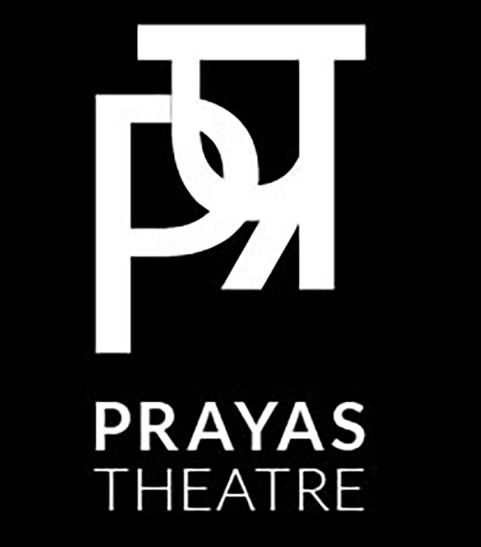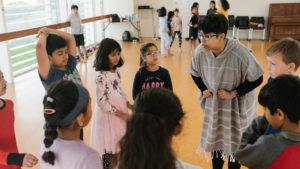
They say necessity is the mother of invention, in my case it is the mother of reinvention! I constantly learn and reinvent myself to fill in the gaps. These gaps are very evident in community theatre, especially ethnic communities. I started costume designing because I could not find a South Asian costume designer for my own productions and shoots. 15 years on I am here writing about my experience!
I have always held a love for fabric, colours, and artistry for as long as I can remember. It was only natural that these interests combined led me to costume design and makeup artistry.
On Costume Design and Makeup
Clear understanding of the script, the director’s vision and how the project will be produced is critical, and my designs are strongly led by the storyteller in me. DARA for example, was set in a specific historical era, much research was done to simulate the fashion of the time. When I took the creative liberty, it was to accommodate budget constraints along with comfort and health and safety on stage.
South Asian audiences are very familiar with epic period Indian films such as Padmaavat, Bajirao Mastani and Jodha Akbar to name a few, with the Mughal backdrops. It was
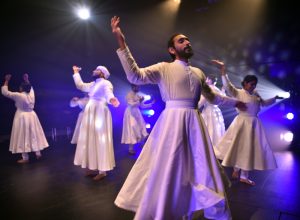
important to ensure audiences were not comparing production values, so creating the extravaganza with a twist was essential, which is what led to my pitch of 26 Sufi dancers retelling the story of Dara. All the actors were measured and fitted with custom-made Sufi inspired base costumes, the characters nuances were accentuated by specific style, silhouette, accessories, textures and any unique features of each costume was purely driven by the character or the scene. Carefully manicured beards and kohl on men worked like a charm.
Picking the battle was key – the ‘non negotiable’ costume element, Shah Jahan’s crown, was entirely designed and constructed in Pakistan. Maintenance of the 26 sets of white costumes in pristine condition, steaming the Sufi skirts and starch ironing the kurtas for the entire season was excruciating. Let’s just say I wasn’t the Stage Managers’ favourite creative! I learnt through the process that all great ideas come with 3 hours of post-show care!
On Prayas
My journey into the creative industry started with Prayas, it has been part of me for nearly 15 years, starting with Charandas Chor in 2005 to Yatra in 2020. Prayas is family, and like family you eventually know everyone, really well! After years of working with Amit O, you really know him. You know the meaning of his ‘hmms’ and ‘okays’. Every twitch of the eye is a question or statement, every movement of his brow is an exclamation.
Over the years I have grown as an artist and Prayas has nurtured this process. The sharing of knowledge is mutual, Prayas has provided me with the platform to showcase my talents and I bring back my professional experience, research and training to Prayas from my other creative adventures.
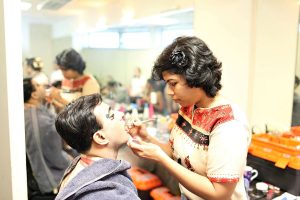 Kia kaha is something Prayas does subconsciously, it’s part of the original culture and Sudeepta Vyas is the essence of Kia kaha. For me she is the Fevicol of Prayas – tootega nahin!
Kia kaha is something Prayas does subconsciously, it’s part of the original culture and Sudeepta Vyas is the essence of Kia kaha. For me she is the Fevicol of Prayas – tootega nahin!
I have designed many posters collaboratively with Bhavnesh Soni – for “The Mourning After” poster we were up till 4am finalising the design! I’ve learnt that when you find a tribe of creatives, hold on to them, especially collaborators who have patience to understand your mind but also assertive enough to say “Bus ho gaya yaar, aur nahi ho sakta!”
These are friendships forged in the fire. Prayas has given me many of these relationships, that are also lifelong friends and mentors.
As theatre makers, we have come a long way. From borrowing sarees from my mother’s secure collection to custom costume construction for a specific production!
On Kaupapa
Every designer brings their own kaupapa along with their creative energy. Sustainability, inclusivity and authenticity are in the forefront of my creations. Op shopping and repurposing old pieces to create hybrid collections is exciting. Sometimes I must make purely ethical decisions, decisions I never thought I would need to make.
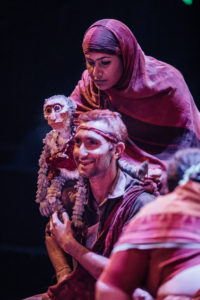 I once found two identical stunning shirts for $7 at an OP Shop, perfect fit, shade and design. Jackpot! I was very thrilled with my find but instantly in a dilemma. If I purchased this shirt to distress (distressing refers to a surface treatment that makes the material appear faded like wear and tear), another person might potentially lose out on a shirt for $3.50 which could be crucial for a job interview. It is hypothetical but it’s a possibility. I didn’t buy the shirts. I may or may not have regretted that decision, but at that point of time, that was the right decision to make.
I once found two identical stunning shirts for $7 at an OP Shop, perfect fit, shade and design. Jackpot! I was very thrilled with my find but instantly in a dilemma. If I purchased this shirt to distress (distressing refers to a surface treatment that makes the material appear faded like wear and tear), another person might potentially lose out on a shirt for $3.50 which could be crucial for a job interview. It is hypothetical but it’s a possibility. I didn’t buy the shirts. I may or may not have regretted that decision, but at that point of time, that was the right decision to make.
Subtle messages can be presented on stage and representation matters, be it how I style South Asian women, LGBTQIA+ characters or make choices to represent people from different walks of life by conscious decision making for characters with ambiguous back stories.
In A Fine Balance 2019, some of the ensemble could be fluid with backstories and I took that opportunity to ensure we had characters from different faiths. My dream of 15 years finally came true, a character with a monobrow (representation matters, bro!). The joy of watching everything fall magically in place on opening night is surreal. Witnessing the terracotta world come alive from design concept was #Phantasmagorical. #IGoogledThisWord
Having worn several creative/ production hats (producer, stage manager, director, production manager, assistant director, choreographer, makeup artist, actor, dancer, costume designer, creative director, Prayas children’s workshop tutor) over the years has added to my storytelling edge. The cross over knowledge is invaluable. The hours are long, that’s no secret, but you learn hacks and smart ways to achieve the big picture goal.
But here is what have I learnt –
There is no ‘right’ or ‘wrong’ way when it comes to designing costumes
When you find your tribe of creatives, you hold on to them! Work ethics and professionalism are more important than talent. And most importantly – don’t forget to have fun!
I still get butterflies on opening night, and that’s how I know I have taken a risk in my creative design.
Padma.
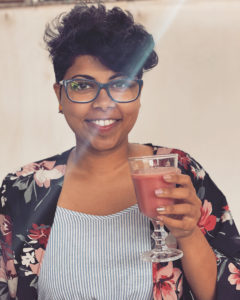
Padma Akula
